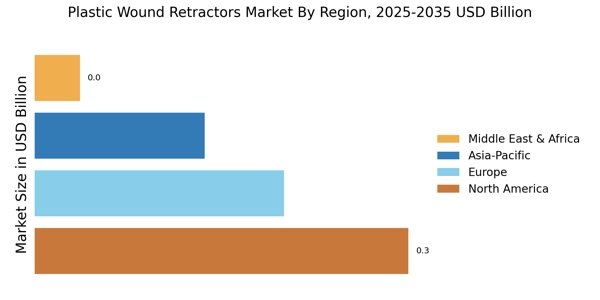Expansion of Healthcare Infrastructure
The ongoing expansion of healthcare infrastructure, particularly in emerging economies, is poised to drive the Plastic Wound Retractors Market. As countries invest in modernizing their healthcare facilities, the demand for advanced surgical instruments is expected to rise. This expansion includes the establishment of new hospitals and surgical centers, which require a comprehensive range of surgical tools, including plastic wound retractors. Market analysis indicates that healthcare spending in developing regions is increasing, with projections suggesting a growth rate of approximately 12% over the next five years. This trend presents a substantial opportunity for manufacturers of plastic wound retractors to penetrate new markets and meet the growing demand.
Increase in Surgical Procedures Worldwide
The rising number of surgical procedures performed across various specialties is a significant driver of the Plastic Wound Retractors Market. Factors such as an aging population, increasing prevalence of chronic diseases, and advancements in surgical techniques contribute to this growth. Recent statistics reveal that the total number of surgeries performed annually is expected to reach over 400 million by 2026. This surge in surgical activity necessitates the use of effective surgical tools, including plastic wound retractors, to ensure optimal surgical outcomes. As the demand for surgeries continues to escalate, the market for these retractors is likely to expand correspondingly.
Rising Demand for Minimally Invasive Procedures
The increasing preference for minimally invasive surgical techniques is a primary driver of the Plastic Wound Retractors Market. These procedures are associated with reduced recovery times, lower risk of complications, and minimal scarring, which appeal to both patients and healthcare providers. As surgical practices evolve, the demand for specialized instruments, including plastic wound retractors, is expected to rise. According to recent data, the market for minimally invasive surgeries is projected to grow at a compound annual growth rate of approximately 10% over the next few years. This trend indicates a robust market potential for plastic wound retractors, as they play a crucial role in enhancing visibility and access during such procedures.
Technological Advancements in Surgical Instruments
Technological innovations in the design and functionality of surgical instruments are significantly influencing the Plastic Wound Retractors Market. The introduction of advanced materials, such as biocompatible plastics, enhances the performance and safety of these devices. Furthermore, the integration of ergonomic designs improves usability for surgeons, thereby increasing efficiency during operations. Market data suggests that the surgical instrument sector is experiencing a shift towards smart technologies, which may include features like integrated lighting or visualization aids. This evolution not only boosts the demand for plastic wound retractors but also positions them as essential tools in modern surgical practices.
Growing Focus on Patient Safety and Infection Control
The heightened emphasis on patient safety and infection control is a critical driver for the Plastic Wound Retractors Market. Hospitals and surgical centers are increasingly adopting protocols that prioritize the reduction of surgical site infections (SSIs). Plastic wound retractors, being single-use and disposable, align with these safety measures, minimizing the risk of cross-contamination. Data indicates that the market for infection control products is expanding, with a projected growth rate of around 8% annually. This trend underscores the importance of incorporating plastic wound retractors into surgical procedures, as they contribute to maintaining sterile environments and enhancing overall patient outcomes.


















Leave a Comment